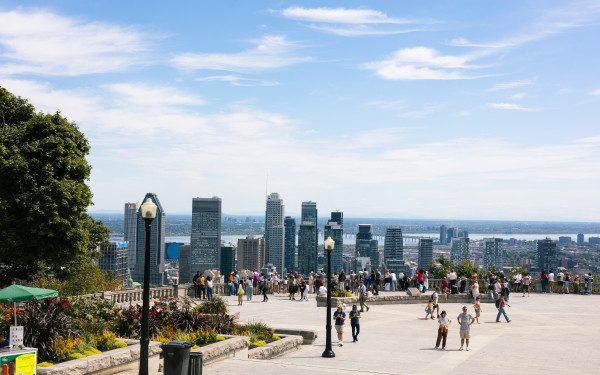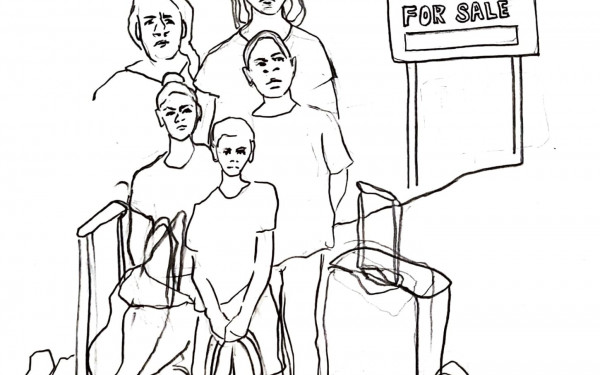What Université de Montréal’s New Campus Means for Parc-Extension
After Evictions, Locals Worry About Gentrification
Outside the city hall of the Villeray–Saint-Michel–Parc-Extension borough, residents shuffled by, one by one.
Some held banners, another a megaphone, and police officers stood nearby as the group grew larger.
Some looked on over to the building facing them just across the street, the Johnny Brown Building. Staring down at Parc metro station from the other side of Hutchison St., the building has long served as a sort of unofficial community centre, having been a home for places of worship, an immigration aid center, family-run businesses, a local radio station, and more. But now it’s fallen into disrepair. Most of its tenants have been evicted, and those remaining will be gone soon to make way for a 70-unit luxury apartment complex.
Protesters stood outside in the cold, hoping the city will back them and stop the project.
“For years we’ve been trying to get social housing, and housing for families, and what do we get? We get a slumlord who decides that he wants to take a piece of our neighbourhood and turn it into whatever he wants,” yelled Adeel Hayat, who’s lived in Parc-Extension for 13 years, through a megaphone.
_900_642_90.jpg)
On Dec. 11, city officials were briefed on recommendations from the new owner of the building, Ron Basal, who hopes the city will approve the permits he needs to continue doing construction on the building. Protesters made their way inside to personally deliver a letter detailing their concerns to the borough, but the group of 20 or so were soon pushed out by police officers. Outside, five police vans were parked to observe the scene.
Basal has no plans to rent the apartments at an affordable price, saying the units will be listed according to “market price,” an offer that’s far from suitable for locals.
Parc-Extension is one of Canada’s poorest neighborhoods, according to a 2016-2017 survey of the area by Centraide of Greater Montreal. Out of all of Montreal’s boroughs, it ranks first place in poverty, with 44 per cent of the neighbourhood currently living with a low income.
It doesn’t end there. Université de Montréal is also encroaching onto the territory. The university is building the first pavilion of a new campus set to open in 2019, between Beaumont and Van Horne Aves., on the southern border of Parc-Extension. With that, many worry the displacement of low income people in Parc-Extension will only continue, seeing the eviction of tenants from the Johnny Brown Building as one step in a longer path towards gentrification.
* * *Hayat doesn’t mince his words.“This university is putting a wall between us and them.”
The four-pavilion campus will house chemistry, physics, geography, and biology departments, and it’s expected to bring in about 10,000 students. The borough announced that UdeM is preparing for the shift by opening up 1,300 student housing units.
“The university is what’s attracting people like [Ron Basal] here,” said Hayat. “This guy’s saying, ‘This is my cash cow.’”
Residents made repeated attempts to express their discontent about the Johnny Brown Building to the borough and the real estate developer, BSR Group. On Dec. 21, some even visited the offices of the real estate company at its Côte Saint-Luc office so they could personally deliver a letter voicing their grievances.
They were not met with a warm welcome. Employees violently pushed the crowd out. A banner reading “Parc-Ex Stands Up for Dignity” was ripped out of one person’s hands. Another filming the scene had an employee hit their camera, and upon leaving, another was heard yelling “I’m going to build condos all over your fucking neighbourhood!”
Basal, the head of the real estate company, said he has plans to continue investing in the neighbourhood.
“We’re looking to buy more condos in the area,” he told The Link in December. “We believe in the great location.”
In response to the evictions, a support group has been formed for the remaining tenants in the Johnny Brown Building. Stéphanie Guay, who’s part of the group, hopes a more open dialogue about the building and gentrification could begin between the borough and its locals.
“The university is what’s attracting people like [Ron Basal] here. This guy’s saying, ‘This is my cash cow.’” – Adeel Hayat
“This is the biggest symbol of gentrification, right at the entrance of the neighbourhood,” she said. “There’s nobody at all from the neighbourhood whos going to live there, that’s absolutely certain.”
Guay’s ultimate dream is to see the building returned to the neighbourhood. At the very least, she hoped the borough would have stepped in to stop the arbitrary evictions at the Johnny Brown Building, and that they’ll step in to stop arbitrary evictions should they happen again.
In a 2013 report, urban planners from the City of Montreal wrote that the new UdeM campus is expected to stimulate the economy and social development for the surrounding area, which includes the area of Parc-Extension from Parc metro station until Beaumont Ave. But Guay, who’s lived in Parc-Extension for seven years, worries the borough might be more caught up in how it’ll improve the area’s economy, and less concerned about the displacement of low income families.
Borough Mayor Giuliana Fumagalli said she wants locals to become more involved by opening a citizen-led consultation group that would focus on improving housing conditions in the area. She also said none of the tenants from the Johnny Brown building directly reached out to her office for help.
The borough said that 30 per cent of the 1,300 units that will open as part of UdeM’s student housing will be affordable social housing. The 2013 report also said that efforts will be made to increase the amount of affordable housing in the neighbourhood, but it’s uncertain what will be done for Parc-Extension in the immediate future.
As part of Projet Montreal’s campaign promise to increase affordable housing in the city, new residential buildings in Montreal with over five units must now allot 40 per cent of those units as affordable social housing.
“It’s a question of making sure we have a community that keeps its character, it’s soul,” said Fumagalli.“It is a concern, and I understand what the citizens are saying.”
Catherine Lussier, coordinator with the local housing rights group Comité d’action de Parc-Extension, said the price of rent in Parc-Extension has been increasing. Between 2014 and 2017, the average cost of rent in the borough jumped from $595 a month to $655 a month, though it’s hard to get an accurate picture of the situation in Parc-Extension specifically, since statistics collected look at the whole borough rather than only that neighbourhood. Property taxes in the borough have gone up by 5.2 per cent this year, so that also stands to increase the price of rent moving forward.
With changes coming for the neighbourhood, long-time residents and students coming in stand to gain from having access to more affordable housing. But about a 1,000 households in Parc-Ex are still on the Office municipal d’habitation de Montréal’s waiting list for subsidised housing, according to Brique par brique, a community housing group looking to establish itself in the neighbourhood.
There is also a lack of housing co-op groups—only two serve entire neighbourhood. That makes for a total of 55 low-income cooperative housing units, compared to the 431 that exist in neighbouring Villeray. And as Sarita Ahooja, a Parc-Extension resident who’s lived in a housing co-op since 2009, has noticed, most of the housing co-ops in Montreal are insular. Like any other organization, Ahooja’s said that housing co-ops tend to reproduce the same structure as the society they exist in.
“Here the co-op movement is still very Québécois,” she said. “People still stick to their own.”
As a result, she’s found that many low income people of colour don’t gain access into Montreal’s housing co-ops. She hopes to see stronger anti-racist activism within housing co-ops. In Parc-Extension, this type of work is particularly relevant, given that 47 per cent of the people living there are part of a visible minority.
Faiz Abhuani, executive director of Brique par brique, hopes their community housing group will serve to fill this gap.
4_900_642_90.jpg)
“We’re trying to create a project that deals with the problem of gentrification,” explained Abhuani, who noted that racialized people tend to be the first to be displaced by gentrification.
For that reason, their community housing group will look to serve low income people of colour. They plan to have their 22-unit housing complex open by the summer of 2018.
Looking towards the future, Abhuani said they hope to one day found a community and cultural centre, as Parc-Extension is underserved, especially after the loss of the Johnny Brown Building.
* * *Ron Basal isn’t the only one looking to capitalize on the neighbourhood. Another 21-unit condo building is planned to open this year at 6900 Outremont Ave., just around the corner from the future site of the new campus, despite the fact that most locals are renters. Data from 2016 showed that about 90 per cent of the burrough’s residents live in apartments.
“Nobody really cared about the people here until the property value started being speculated,” Hayat observed.
To make the neighbourhood less attractive to real-estate investors, Fumagalli said she’ll be pushing to change the borough’s zoning laws so that buildings can’t go above a certain height, like two or three stories.
“That stops promoters from grabbing those two story houses, throwing them down and building four stories,” said Fumagalli.
Hannah Blais, a master student in Geography, Urban and Environmental studies at Concordia, said this type of trend is common. Parc-Extension has traditionally housed families—they make up 72 per cent of the area’s population—but new demographics come with new needs.
“It’s the students who pose additional interest. The more students move into a neighbourhood, the more landlords see there is a market opportunity for them,” said Blais.
Neighborhoods flooded by the students tend to see a gradual increase in the overall price of rent, she noted, because landlords often take advantage of students’ short stay. Between each change of lease, it’s not uncommon for landlords to increase the price of rent. Often, renters sign into a lease without the knowledge that the previous tenant paid a lower rent. The more this happens, the more it informs the market, leading other landlords to adjust their own prices in reaction.
Many renters, and students especially, don’t take advantage of their right to refuse arbitrary rent increases, mainly out of a lack of knowledge. This process then contributes to gentrification.
“If we all [refused rent increases], then apartments would stay significantly cheaper,” she said.
Beyond refusing arbitrary rent increases, Blais said students coming in can help fight against gentrification by being more conscious about what they bring to the neighbourhood: Don’t impose a new set of values, support the businesses that were there when you first came in over new ones. Don’t keep yourself isolated from everyone around you. Instead get involved with your neighbourhood by volunteering in your community, and more simply just be a good neighbour, Blais said.
Unfortunately, Hayat noticed that universities tend to foster the opposite.
They rarely teach students about the history of the neighbourhood they’re coming into, and students become so involved in their studies that they can’t focus on anything else, becoming confined from the rest of the people around them.
But students, Hayat said, couldn’t care less.

3_900_642_90.jpg)
_600_832_s.png)




